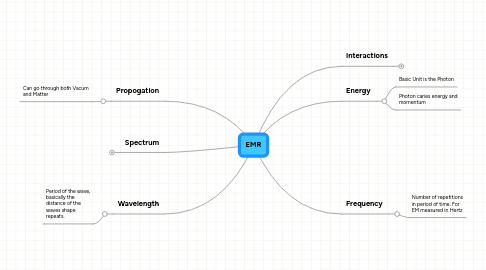
1. Spectrum
1.1. Radio
1.1.1. Lowest Frequency
1.1.2. Highest Wavelength
1.1.3. Produced By Charged Particles Moving Back And Forth
1.1.4. Used mainly for communication, radar and radio astronomy
1.2. Microwave
1.2.1. Frequencies from 300MHz-300GHz
1.2.2. Wavelengths of 1mm-1m
1.2.3. Created by Vacum Tubes which use Clumps of electrons rather than steady stream.
1.2.4. Used for communication, radar, navigation, power/cooking
1.3. Infared
1.3.1. .7 and 300 micrometer wavelength
1.3.2. frequency of 1 and 430THz
1.3.3. Used for thermal applications in both the military and civilian world
1.4. Visible
1.4.1. Interaction with the atmosphere scatters more blue end of the spectrum so mid morning sky appears to be blue.
1.4.2. Frequency of 400-790 Thz
1.4.3. EM strikes objects and reflects therefore allowing color to be seen
1.5. Ultraviolet
1.5.1. Waves of 10-400Nm
1.5.2. Used for Cleaning, Pest Cotrol, authentication, forensics, and purification.
1.6. X-Ray
1.6.1. frequency of 30petahertz-30exahertz
1.6.2. Basically they are used to look inside objects
1.7. Gamma Ray
1.7.1. Have high frequency and very short wavelengths
1.7.2. Created by an atom decaying
1.7.3. Extremely harmful so used for sterilization, also used for some anti cancer treatments
1.8. Order of
2. Propogation
2.1. Can go through both Vacum and Matter
3. Wavelength
3.1. Period of the wave, basically the distance of the waves shape repeats.
4. Interactions
4.1. Reflection, Change in direction
4.1.1. Specular: mirror like
4.1.2. Diffuse: retains energy but looses image
4.2. Refraction: Change in direction due to change in speed. A good example being light going through a different medium
4.3. Dispersion: Phase velocity of wave depends on frequency. Example being a rainbow in which white light is picked apart into different colors and frequencys
4.4. Difraction: When a wave encounters an obstacle so the waves bend. An example being the particles in the atmosphere creating a ring around the sun and moon.
4.5. Interference is the addition of two or more wave patterns that in turn create a new wave.
4.6. Polarization: Describes the orientation of the waves, light exhibits polarization while sound does not(sine wave)
4.7. Absorbtion: EM of a photon is taken up by matter and transformed into a different energy. E.g. the transformation of light to heat when EM comes in contact with matter.
4.8. Scattering is when EM is forced to deviate from straight path. White surfaces scatter all light wavelengths.
4.9. Transparent: Allows light to pass through an object, Translucent: Allows light to be passed through depending on frequency and wavelength eg filters, and Opaque: Scatters radiation in a medium so its neither translucent or transparent
4.10. Fluorescence: Emission of light by matter which has obsorbed EMR. Exaple being using UV(Blacklight) on the glow in the dark items.
4.11. Phosphorescence is like fluorescence but does not immediately reemit the energy but does so over several hours at a lower intensity.
4.12. Color
4.12.1. Physical v. Physiological: Color comes in on certain frequencies but to see the brain relies on certain cells which can alter appearence
4.12.2. Additive: Red, Blue, and green which when combined create secondary colors. Directly admitted from light
4.12.3. Subtractive: Magenta, Cyan, Yellow when combined or used take away wavelengths giving it color. Filters and the like
